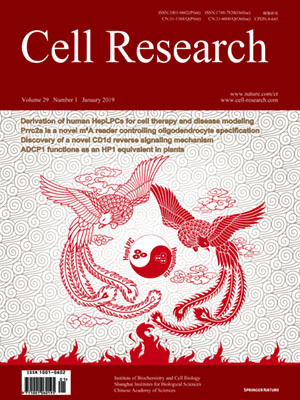
Volume 29, No 1, Jan 2019
ISSN: 1001-0602
EISSN: 1748-7838 2018
impact factor 17.848*
(Clarivate Analytics, 2019)
Volume 29 Issue 1, January 2019: 80-82
LETTERS TO THE EDITOR
Cap-specific, terminal N6-methylation by a mammalian m6Am methyltransferase
Hanxiao Sun 1, Meiling Zhang 1, Kai Li 1,2,3, Dongsheng Bai 1 and Chengqi Yi 1,3,4
1State Key Laboratory of Protein and Plant Gene Research, School of Life Sciences, Peking University, Beijing 100871, China; 2Academy for Advanced Interdisciplinary Studies, Peking University, Beijing 100871, China; 3 Peking-Tsinghua Center for Life Sciences, Peking University, Beijing, China and 4Department of Chemical Biology and Synthetic and Functional Biomolecules Center, College of Chemistry and Molecular Engineering, Peking University, Beijing 100871, China
These authors contributed equally: Hanxiao Sun, Meiling Zhang
Correspondence: Chengqi Yi (chengqi.yi@pku.edu.cn)
Dear Editor,
Dynamic and reversible N6-methyladenosine (m6A) RNA methylation has been found to greatly impact gene expression, leading to the field of epitranscriptomics.1 Unlike m6A that is an internal modification, a terminal modification at mRNA cap in higher eukaryotes exists, termed as N6,2′-O-dimethyladenosine (m6Am) (Fig. 1a). The first and sometimes the second nucleotide after the N7-methylguanosine (m7G) cap can be methylated at the 2′-hydroxyl group; and when the first nucleotide is 2′-O-methyladenosine (Am), it can be further methylated at the N6 position to become m6Am. m6Am was first identified in animal cells and virus mRNA in 19752; several years later the methyltransferase was partially purified and was proposed to be a species whose molecular weight is ~65 KD.3 Only very recently, m6Am was found to be reversible as well: the first m6A demethylase FTO also catalyzed the demethylation of m6Am, depending on its sub-cellular localizations.4,5 By changing FTO levels, m6Am at mRNA cap was also suggested to impair DCP2-mediated mRNA decapping.4 However, the methyltransferase of m6Am is not unambiguously identified, significantly hindering the functional and mechanistic study of m6Am.
https://doi.org/10.1038/s41422-018-0117-4
FULL TEXT | PDF
Browse 1460


